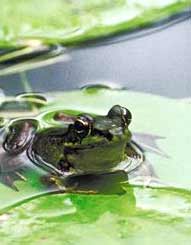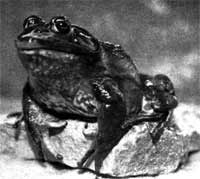|

 Big mommas: This is a large species and can grow to a length of 6 inches (15 cm) with a weight of upto 1.5 lb (750 g). Females are typically larger than males. They are generally varying shades of green or brown, with dark brown, dark green, or black blotching and a yellow or white underside. Big mommas: This is a large species and can grow to a length of 6 inches (15 cm) with a weight of upto 1.5 lb (750 g). Females are typically larger than males. They are generally varying shades of green or brown, with dark brown, dark green, or black blotching and a yellow or white underside.
Suprascalpula for the long jump: The skeleton of an adult frog consists of bone, hyaline cartilage, and calcified cartilage. The calcified cartilage can be found throughout the body of the frog, its particularly more noticeable in the epiphyses of the long bones in the limbs and shoulder-gridle, etc. The frog not only has a scalpula, but a suprascalpula which allows for greater range of motion for long jumps. In the frog the radius and ulna have become fused into a single bone, the radio-ulna, and the tibia and fibula have become fused into a single bone, the tibio-fibula.

 Sounds like a bull: The American Bull Frog uses its skin, Buccal Cavity, and lungs for respiration. Cutaneous ("skin") gas exchange is very important in all amphibians. They are aptly named, as their call is an extremely loud, guttural bellow that carries a long distance, giving the impression that the frog is much larger than it actually is. Sounds like a bull: The American Bull Frog uses its skin, Buccal Cavity, and lungs for respiration. Cutaneous ("skin") gas exchange is very important in all amphibians. They are aptly named, as their call is an extremely loud, guttural bellow that carries a long distance, giving the impression that the frog is much larger than it actually is.
Diet -eats anything that fits in mouth: This species is carnivorous and will consume almost anything that fits into their mouth which they can overpower, including insects, small mammals, fish, birds, turtles, snakes, and even other frogs.
 The American Bull Frog is native to North America. They are found in the United States, Canada and Mexico, east of the Rocky Mountains, but have been introduced to many other localities throughout the world. In Europe and the western U.S. measures are often taken to control its spread because it competes with, and often drives out, native species. The American Bull Frog is native to North America. They are found in the United States, Canada and Mexico, east of the Rocky Mountains, but have been introduced to many other localities throughout the world. In Europe and the western U.S. measures are often taken to control its spread because it competes with, and often drives out, native species.

 Three main stages of life for a bullfrog: The male reproductive organs are the testes and their duct, and the female have ovaries. In the spring the male calls the female from the water. The female lays up to 25,000 eggs, and these eggs will become tadpoles. Their metamorphosis brings them the organs that are only found in the adult frogs and takes between 12-24 months. There are three major changes that take place during the metamorphosis: 1) Premetamorphisis which is when the embryo genesis and growth and development occur, during this time the thyroid gland is absent. 2) Prometamorphisis is the period in which the concentration of the endogenous thyroid hormone rises 3) Metamorphosis is the period when the tadpole's tail shrinks back into the frog's body. Other organs too undergo changes such as the liver and the intestine and the gills will be gone as well. The adult frog can live up to 15 years. Three main stages of life for a bullfrog: The male reproductive organs are the testes and their duct, and the female have ovaries. In the spring the male calls the female from the water. The female lays up to 25,000 eggs, and these eggs will become tadpoles. Their metamorphosis brings them the organs that are only found in the adult frogs and takes between 12-24 months. There are three major changes that take place during the metamorphosis: 1) Premetamorphisis which is when the embryo genesis and growth and development occur, during this time the thyroid gland is absent. 2) Prometamorphisis is the period in which the concentration of the endogenous thyroid hormone rises 3) Metamorphosis is the period when the tadpole's tail shrinks back into the frog's body. Other organs too undergo changes such as the liver and the intestine and the gills will be gone as well. The adult frog can live up to 15 years.
All text is available under the terms
of the GNU Free Documentation License
|